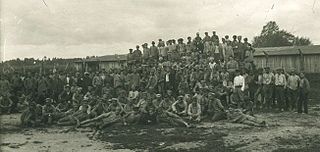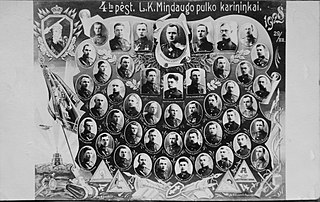
The Lithuanian Wars of Independence, also known as the Freedom Struggles, refer to three wars Lithuania fought defending its independence at the end of World War I: with Bolshevik forces, Bermontians, and Poland. The wars delayed international recognition of independent Lithuania and the formation of civil institutions.

Stasys Raštikis was a Lithuanian military officer, ultimately obtaining the rank of divisional general. He was the commander of the Lithuanian Army from September 21, 1934, to April 23, 1940.

Petras Kubiliūnas was a Lithuanian lieutenant general and Chief of the Lithuanian General Staff in 1929–1934.

Maksimas Katche, was a Russian colonel and Lithuanian lieutenant general.

Silvestras Žukauskas was a Lithuanian General. He first served in the Imperial Russian Army, where he distinguished himself during World War I, rising to the rank of major general and ending the war as divisional commander. Later he joined the Lithuanian Army and was its Chief Commander three times: May–September 1919, February–June 1920, and June 1923 to January 1928.

The Lithuanian–Soviet War or Lithuanian–Bolshevik War was fought between newly independent Lithuania and the Russian Socialist Federative Soviet Republic in the aftermath of World War I. It was part of the larger Soviet westward offensive of 1918–1919. The offensive followed the retreat of German troops and sought to establish Soviet republics in Ukraine, Belarus, Lithuania, Latvia, Estonia, Poland and link up with the German Revolution. By the end of December 1918 Soviet forces reached Lithuanian borders. Largely unopposed, they occupied one town after another and by the end of January 1919 controlled about two thirds of the Lithuanian territory. In February, the Soviet advance was stopped by Lithuanian and German volunteers, who prevented the Soviets from capturing Kaunas, the temporary capital of Lithuania. From April 1919, the Lithuanian war went parallel with the Polish–Soviet War. Poland had territorial claims over Lithuania, especially the Vilnius Region; these tensions spilt over into the Polish–Lithuanian War.

The Lithuanian Soviet Socialist Republic (LSSR) was a short-lived Soviet Puppet state during early Interwar period. It was declared on 16 December 1918 by a provisional revolutionary government led by Vincas Mickevičius-Kapsukas. It ceased to exist on 27 February 1919, when it was merged with the Socialist Soviet Republic of Byelorussia to form the Lithuanian–Byelorussian Soviet Socialist Republic (Litbel). While efforts were made to represent the LSSR as a product of a socialist revolution supported by local residents, it was largely a Moscow-orchestrated entity created to justify the Lithuanian–Soviet War. As a Soviet historian described it as: "The fact that the Government of Soviet Russia recognized a young Soviet Lithuanian Republic unmasked the lie of the USA and British imperialists that Soviet Russia allegedly sought rapacious aims with regard to the Baltic countries." Lithuanians generally did not support Soviet causes and rallied for their own national state, declared independent on 16 February 1918 by the Council of Lithuania.

Vincas Vitkauskas was a Lithuanian general. He became commander of the Lithuanian Army after the resignation of Stasys Raštikis in January 1940. In this capacity, Vitkauskas opposed armed resistance to the Soviet occupation in June 1940 and subsequently collaborated with the new Soviet regime.

Jonas Semaška, nom de guerreLiepa, Rikis, Gaučas was a Lithuanian officer of the Lithuanian Army, the Red Army's 29th Rifle Corps and then the Lithuanian Auxiliary Police Battalions formed by Nazi Germany. Semaška was a leader of Lithuanian partisans, who fought for Lithuanian independence.
2nd Infantry Regiment later known as the 2nd Infantry Regiment of the Lithuanian Grand Duke Algirdas was a Lithuanian Army infantry regiment that saw combat in the Lithuanian Wars of Independence. It existed from 1918 to 1940. The current Lithuanian arm's Grand Duke Algirdas Mechanised Infantry Battalion continues the 2nd Regiment's traditions.
Tadas Chodakauskas was the long-standing mayor of Panevėžys, Lithuania (1925–1940).

4th Infantry Regiment, later the 4th Infantry Regiment of the Lithuanian King Mindaugas was a Lithuanian Army infantry regiment that existed from 1918 to 1940 and was located in Panevėžys.

The Lithuanian People's Army were short-lived armed forces of Lithuania and the Lithuanian Soviet Socialist Republic following the Soviet occupation of Lithuania in June 1940. The army was formed by the Act of 3 July 1940 of the People's Government of Lithuania and replaced the Lithuanian Armed Forces of independent Lithuania. According to data from 1 June 1940, the army had 28,115 persons – 26,084 soldiers, 2,031 civil servants, and with the announcement of the mobilization it was possible to call 120,400 reserve troops. The army existed until 30 August 1940 before being transformed into the 29th Rifle Corps of the Red Army. Many Lithuanian soldiers and officers were repressed by arrests or executions for their anti-Soviet attitude.

Antanas Gaušas was a Lithuanian military person, who became Colonel of the General Staff in 1937.

The 9th Infantry Regiment, later the 9th Infantry Regiment of the Lithuanian Duke Vytenis was an infantry regiment that served in the Lithuanian Army during the Interwar period. The battalion successfully fought against the invading Bolsheviks during the Lithuanian Wars of Independence. The regiment was founded on 20 May 1919.
The 5th Infantry Regiment, later the 5th Infantry Regiment of the Lithuanian Grand Duke Kęstutis was an infantry regiment that served in the Lithuanian Army during the Interwar period.

Stasys Pundzevičius was a Lithuanian division general and lecturer. He held high-ranking military positions in the interwar Lithuania: Chief of the Lithuanian Air Force, Chief of the General Staff, multiple times temporarily was the Chief of the Lithuanian Armed Forces, and was assigned Chief of the Lithuanian Armed Forces by the Provisional Government of Lithuania during the June Uprising in Lithuania.

The Battle of Jieznas was one of the first battles of the recreated Lithuanian Army against the Red Army near Jieznas during the Lithuanian Wars of Independence. This Lithuanian victory contributed significantly to an increase in Lithuanian morale. The further Bolshevik offensive into Lithuania was stopped at the battles of Kėdainiai, Jieznas and Alytus.

The Battle of Giedraičiai was fought on November 17–21, 1920, between the Lithuanian Army and a part of the Polish Army led by Lucjan Żeligowski, which called itself the Army of Central Lithuania.
Kazys Ališauskas was a Lithuanian military officer and historian.

















